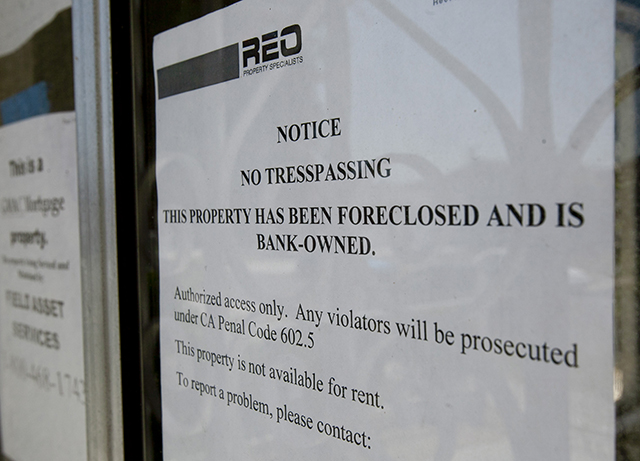
A “No Trespassing” sign is posted on a bank owned foreclosed home being offered for sale Tuesday, May 31, 2011, in Los Angeles. (AP Photo/Damian Dovarganes)
Nationally, 17 percent of homeowners are underwater — they owe more on their mortgages than their homes are actually worth. In Ferguson, that figure sits at 50 percent. Because so many homeowners are struggling, the town is ripe for institutional investors — often hedge funds or private equity groups on the coasts, thousands of miles away — to buy up homes, then rent them to low-income tenants. And that’s what has happened. Investment firms are responsible for roughly a quarter of all recent housing purchases in the town.
Goldstein profiled two Ferguson families renting from one Los Angeles-based investment firm, Raineth Housing:
Housing advocates worry about what will happen if investors in firms like Raineth become dissatisfied with the returns from leasing homes to low-income families. The commitment of out-of-state landlords to maintaining properties also is a concern. Tenants and local housing officials have given Raineth mixed grades as a landlord.
Mr. Bryant, 24, who lives on Mueller Avenue in Ferguson, said he and his mother had been generally pleased with their home, which they have rented for four years. He said the landlord’s property manager had been fairly responsive about making repairs, although Mr. Bryant said the house, which has white siding and burgundy trim, “needs to be worked on, or updated.”
The Walkers, who moved into their two-bedroom white brick home on La Motte Lane a year ago, tell a different story. Ethel Walker, 54, a custodian at a local school, said her asthma has worsened because of a persistent mold problem in the house, which she blames on a leaky pipe and water in the basement. More recently, Ms. Walker and her daughter said they had had to deal with raw sewage gurgling up in their yard.
“When you’d flush the toilet it’d come up in the backyard,” Tasha Walker, 31, said.
As Goldstein notes, tenant advocates say the problem comes when investors try to turn too quick a profit on their investment — or fail to turn a profit at all. In New York City, for example, private equity firms have invested in neighborhoods — often low-income communities that investors were unfamiliar with — where the economics of their investment didn’t work out and tenants suffered. In some cases, residents watched their buildings fall into disrepair as their new Wall Street landlords sought to wring maximum profit. In others, tenants faced intense pressure to leave their homes as new landlords tried to gentrify neighborhoods and raise rents. Tenants’ rights groups have dubbed this style of landlordship “predatory equity.”
These practices have spread far beyond urban neighborhoods to the suburbs, where an abundance of cheap homes are teetering on the brink of foreclosure. In the wake of the housing crisis, Bloomberg reported, Blackstone Group raised $20 billion to purchase “as many as 200,000 homes.” As of 2013, the fund was renting residences in 14 cities. Ferguson was “largely avoided” by Blackstone, Goldstein writes, but other investment groups filled the gap.
So increasingly, in Ferguson and across America, homes that went through foreclosure during the crisis are now owned by large financial entities, many of which are staffed by individuals who had a hand in creating the crisis in the first place. And increasingly, Americans are renting from them.
But this issue too — specifically in Ferguson — comes back to race. In his cover story for The Atlantic, “The Case for Reparations,” Ta-Nehisi Coates pointed to housing as one key area of society in which racism has become institutionalized. The foreclosure crisis is one of his more recent examples:
In 2010, Jacob S. Rugh, then a doctoral candidate at Princeton, and the sociologist Douglas S. Massey published a study of the recent foreclosure crisis. Among its drivers, they found an old foe: segregation. Black home buyers—even after controlling for factors like creditworthiness—were still more likely than white home buyers to be steered toward subprime loans.
The chart below shows that people of color with good credit received high-interest mortgages or subprime mortgages far more often than white borrowers with similar credit. These mortgages were meant for only the riskiest borrowers. Because of their higher rates, houses purchased with these mortgages were harder to pay off, and were more likely to face foreclosure.
As I wrote earlier this year, this phenomenon — giving too many higher-rate mortgages to families of color who qualified for more traditional mortgages — was one reason why the housing bubble burst. It also helps explain why minorities were hit harder by the Great Recession.
Ferguson is roughly two-thirds black, and white residents are moving away. The town’s racial shift occurred in the run-up to, and during, the recession. It seems very likely that the town’s growing black population, and its large number of underwater homeowners, are related: Housing is a major factor tying America’s fraught relationship with race and the recent financial crisis. And both contributed to the unrest in Ferguson.
This work is licensed under a Creative Commons Attribution-NoDerivatives 4.0 International License.


